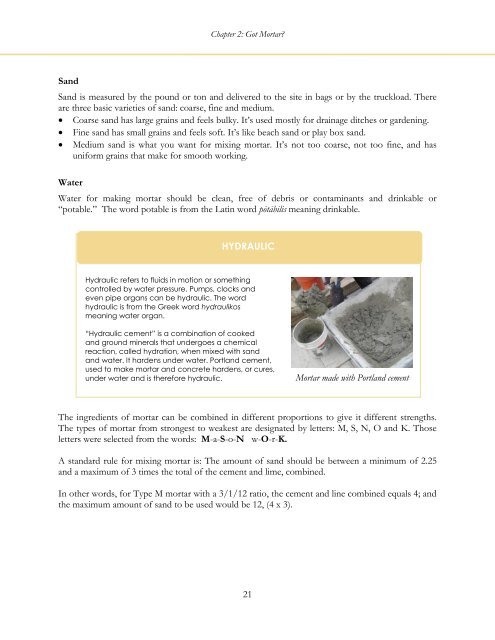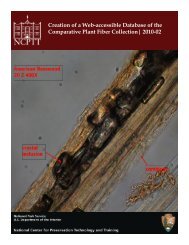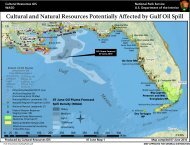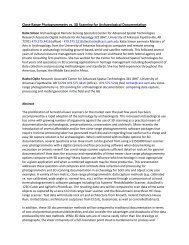- Page 2 and 3: This publication was developed unde
- Page 4 and 5: Introduction Abyssinian Development
- Page 6 and 7: Introduction A photograph, portrait
- Page 8 and 9: Introduction Three math problems we
- Page 10 and 11: Introduction The best revenge again
- Page 12 and 13: Table of Contents Building of the E
- Page 14 and 15: Table of Contents Pouring Concrete:
- Page 16 and 17: Table of Contents Activities 157 1.
- Page 18 and 19: Chapter 1: What is Masonry? Chapter
- Page 20 and 21: Chapter 1: What is Masonry? Masonry
- Page 22 and 23: Chapter 1: What is Masonry? The too
- Page 24 and 25: Chapter 1: What is Masonry? PLUM AN
- Page 26 and 27: Chapter 1: What is Masonry? Things:
- Page 28 and 29: Chapter 1: What is Masonry? Mechani
- Page 30 and 31: Chapter 1: What is Masonry? ACTIVIT
- Page 32 and 33: Chapter 1: What is Masonry? 3. Addi
- Page 34 and 35: Chapter 2: Got Mortar? What’s Mor
- Page 36 and 37: Chapter 2: Got Mortar? Lime mortars
- Page 40 and 41: Chapter 2: Got Mortar? Shovel comes
- Page 42 and 43: Chapter 2: Got Mortar? MORTAR JOINT
- Page 44 and 45: Chapter 2: Got Mortar? Places, Thin
- Page 46 and 47: Chapter 2: Got Mortar? Quotes and L
- Page 48 and 49: Chapter 2: Got Mortar? 2. Scooping
- Page 50 and 51: Chapter 2: Got Mortar? To get the v
- Page 52 and 53: Chapter 3: Why Are Bricks Red? Bric
- Page 54 and 55: Chapter 3: Why Are Bricks Red? Tech
- Page 56 and 57: Chapter 3: Why Are Bricks Red? Bloc
- Page 58 and 59: Chapter 3: Why Are Bricks Red? Some
- Page 60 and 61: Chapter 3: Why Are Bricks Red? The
- Page 62 and 63: Chapter 3: Why Are Bricks Red? Andr
- Page 64 and 65: Chapter 3: Why Are Bricks Red? The
- Page 66 and 67: Chapter 3: Why Are Bricks Red? Syno
- Page 68 and 69: Chapter 3: Why Are Bricks Red? Proc
- Page 70 and 71: Chapter 4: The city rocks! Stone Su
- Page 72 and 73: Chapter 4: The city rocks! Metamorp
- Page 74 and 75: Chapter 4: The city rocks! Pointed
- Page 76 and 77: Chapter 4: The city rocks! - If a m
- Page 78 and 79: Chapter 4: The city rocks! MOHS’
- Page 80 and 81: Chapter 4: The city rocks! MEDAL OF
- Page 82 and 83: Chapter 4: The city rocks! The Reco
- Page 84 and 85: Chapter 4: The city rocks! 1. Carvi
- Page 86 and 87: Chapter 4: The city rocks! Con
- Page 88 and 89:
Chapter 5: Terra Whatt-a? Terra Wha
- Page 90 and 91:
Chapter 5: Terra Whatt-a? Knowing T
- Page 92 and 93:
Chapter 5: Terra Whatt-a? Stainless
- Page 94 and 95:
Chapter 5: Terra Whatt-a? TERRA COT
- Page 96 and 97:
Chapter 5: Terra Whatt-a? People: W
- Page 98 and 99:
Chapter 5: Terra Whatt-a? Above the
- Page 100 and 101:
Chapter 5: Terra Whatt-a? One of th
- Page 102 and 103:
Chapter 5: Terra Whatt-a? It includ
- Page 104 and 105:
Chapter 5: Terra Whatt-a? ACTIVITIE
- Page 106 and 107:
Chapter 5: Terra Whatt-a? Note: Fol
- Page 108 and 109:
Chapter 6: That’s Concrete? It’
- Page 110 and 111:
Chapter 6: That’s Concrete? have
- Page 112 and 113:
Chapter 6: That’s Concrete? Cast
- Page 114 and 115:
Chapter 6: That’s Concrete?
- Page 116 and 117:
Chapter 6: That’s Concrete? Pour
- Page 118 and 119:
Chapter 6: That’s Concrete? WORLD
- Page 120 and 121:
Chapter 6: That’s Concrete? Thoma
- Page 122 and 123:
Chapter 6: That’s Concrete? Corpo
- Page 124 and 125:
Chapter 6: That’s Concrete? ACTIV
- Page 126 and 127:
Chapter 6: That’s Concrete? Tamp
- Page 128 and 129:
Chapter 7: It’s Plaster Chapter 7
- Page 130 and 131:
Chapter 7: It’s Plaster However,
- Page 132 and 133:
Chapter 7: It’s Plaster became th
- Page 134 and 135:
Chapter 7: It’s Plaster If keys h
- Page 136 and 137:
Chapter 7: It’s Plaster People, P
- Page 138 and 139:
Chapter 7: It’s Plaster WWII STAT
- Page 140 and 141:
Chapter 7: It’s Plaster Buildings
- Page 142 and 143:
Chapter 7: It’s Plaster Testimoni
- Page 144 and 145:
Chapter 7: It’s Plaster Procedure
- Page 146 and 147:
Chapter 8: Stucco and Masonry Paint
- Page 148 and 149:
Chapter 8: Stucco and Masonry Paint
- Page 150 and 151:
Chapter 8: Stucco and Masonry Paint
- Page 152 and 153:
Chapter 8: Stucco and Masonry Paint
- Page 154 and 155:
Chapter 8: Stucco and Masonry Paint
- Page 156 and 157:
Chapter 8: Stucco and Masonry Paint
- Page 158 and 159:
Chapter 8: Stucco and Masonry Paint
- Page 160 and 161:
Chapter 9: Clean Outside—Façade
- Page 162 and 163:
Chapter 9: Clean Outside—Façade
- Page 164 and 165:
Chapter 9: Clean Outside—Façade
- Page 166 and 167:
Chapter 9: Clean Outside—Façade
- Page 168 and 169:
Chapter 9: Clean Outside—Façade
- Page 170 and 171:
Chapter 9: Clean Outside—Façade
- Page 172 and 173:
Chapter 9: Clean Outside—Façade
- Page 174 and 175:
Chapter 9: Clean Outside—Façade
- Page 176 and 177:
Chapter 10: Maintenance - Care and
- Page 178 and 179:
Chapter 10: Maintenance - Care and
- Page 180 and 181:
Chapter 10: Maintenance - Care and
- Page 182 and 183:
Chapter 10: Maintenance - Care and
- Page 184 and 185:
Chapter 10: Maintenance - Care and
- Page 186 and 187:
Chapter 10: Maintenance - Care and
- Page 188 and 189:
Chapter 10: Maintenance - Care and
- Page 190 and 191:
Chapter 10: Maintenance - Care and
- Page 192 and 193:
Chapter 11: Up on the Roof Chapter
- Page 194 and 195:
Chapter 11: Up on the Roof Standing
- Page 196 and 197:
Chapter 11: Up on the Roof Modified
- Page 198 and 199:
Chapter 11: Up on the Roof Copings
- Page 200 and 201:
Chapter 11: Up on the Roof finger a
- Page 202 and 203:
Chapter 11: Up on the Roof People,
- Page 204 and 205:
Chapter 11: Up on the Roof At night
- Page 206 and 207:
Chapter 11: Up on the Roof 2. Repai
- Page 208 and 209:
Chapter 12: Here Today, Green Tomor
- Page 210 and 211:
Chapter 12: Here Today, Green Tomor
- Page 212 and 213:
Chapter 12: Here Today, Green Tomor
- Page 214 and 215:
Chapter 12: Here Today, Green Tomor
- Page 216 and 217:
Chapter 12: Here Today, Green Tomor
- Page 218 and 219:
Chapter 12: Here Today, Green Tomor
- Page 220 and 221:
Chapter 12: Here Today, Green Tomor
- Page 222 and 223:
Chapter 12: Here Today, Green Tomor
- Page 224 and 225:
Chapter 12: Here Today, Green Tomor
- Page 226 and 227:
Closing Closing The Conclusion and
- Page 228 and 229:
Closing I see trees of green, red r
- Page 230 and 231:
Closing The bright blessed day, dar
- Page 232 and 233:
Closing …of people going by. I se
- Page 234 and 235:
Closing Yes, I think to myself… W
- Page 236 and 237:
Closing About history Guilds The
- Page 238 and 239:
Closing trade schools skyscrapers
- Page 240 and 241:
Closing This primer is about masonr
- Page 242 and 243:
Web Resources “Craft Guilds and C
- Page 244 and 245:
Web Resources The Tools: Jointers a
- Page 246 and 247:
Web Resources http://www.humanities
- Page 248 and 249:
Web Resources Who? Arthur MacArthur
- Page 250 and 251:
Web Resources “Hampton and Its St
- Page 252 and 253:
Web Resources Quotes “Captain Joh
- Page 254 and 255:
Web Resources The “How” of Stuc
- Page 256 and 257:
Web Resources Preparations, Precaut
- Page 258 and 259:
Web Resources “Benjamin C. Thomps
- Page 260 and 261:
Web Resources Urban homesteading
- Page 262 and 263:
Photograph and Illustration Credits
- Page 264 and 265:
Web Resources Civil War battle. Lib
- Page 266 and 267:
Web Resources Soldiers in Wernberg,
- Page 268 and 269:
Web Resources Saint Thomas Builders
- Page 270:
About the Author 253











